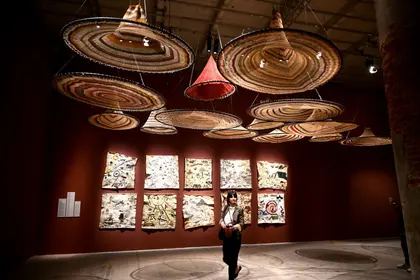The 2023 Venice Biennale of Architecture, one of the world’s premier gatherings for architecture and design, kicks off officially on Saturday, May 20. In this edition, there will be a significant Ukrainian presence in the form of a cultural project organized by a team of Ukrainian architects, artists and historians, with the support of Italian sponsors and Ukrainian associations.
DNA Ucraino (Ukrainian DNA) will take place from May 18 to June 20 on the island of Giudecca, at the Sala del Camino of the Monastery of Saints Cosma and Damiano. This is an incredible opportunity to plunge into the beauty and richness of Ukrainian culture.
JOIN US ON TELEGRAM
Follow our coverage of the war on the @Kyivpost_official.
Giudecca has become, in recent years, a special place for culture in Venice. The Cloister of Saints Cosma and Damiano is also a meeting place for artists and critics, in the galleries, which have settled in this wonderful corner of the lagoon city.
The entire community of Ukrainian architects, designers and artists have been mobilized for this exhibition, as Ukraine has not participated in the Biennale of Architecture since 2016. This year’s theme “Laboratory of the Future” is particularly meaningful for Ukrainian architects today. But what can Ukrainians tell the world in this unique moment of their history? Their collective memory is filled with events from their struggle to resist invasions and preserve their identity.
DNA Ucraino aims to delve into the genius loci of Ukrainian culture on its territory, with a futuristic vision for rebuilding in a manner that should maintain the characteristic features of Ukraine. The destruction of historical, cultural, and architectural landmarks by Russian occupiers highlights the significance of this project in conveying the genuine history of Ukraine by drawing architectural parallels. The architecture preserved on the territory of Ukraine attests to the emergence of the statehood and culture of Kyivan Rus. The exhibition program also intends to show the pan-European genesis of Ukraine, which has always been a part of Europe, with values laid down in previous centuries.
This interdisciplinary project at the intersection of architecture, bio-design, and art is a material, spatial and temporal journey through the moments of Ukrainian history that have directly or indirectly influenced European history.
Like genes in a DNA chain, it connects different visual styles from Trypillian culture to the present, shaping our modern face. The Ukrainian DNA project is a significant milestone in bridging gaps in our understanding of the past. Despite its fragility and sensitivity, it carries a powerful transformative force, promoting effective cultural dialogue and mutual integration of Ukrainian and European contexts. Preserving traditions, identity and creating a vision of the future for the strategy of rebuilding Ukraine.
As such, the works on site represent iconographies of the history of Ukraine and will act as a scenography and narrative through images for the space that will host meetings between Ukrainian artists, curators, historians and architects with the international community. The installation is a material, spatial and temporal journey through the moments of Ukrainian history and present time.
The installation was set up thanks to the work of Design4Ukraine and cooperation between the artists Darya Alyoshkina, Diana Bilchenko and Ornella Ostapenko. The team of artists created the scenography with artworks: “Lace of Centuries'” a series of 12 large paper panels by vytynanka, an ancient technique of carving drawings on paper; works made on mass roots of wheat called “Rhizome”; graphic icons based on research history of Ukraine by periods made by Ornella Ostapenko; the exposition “Ukrainian DNA” completed with the “Humanless,” anatomy of a table by NÙEVÙ Studio.
Finally, the exhibition shows the time capsule “HERE and NOW”–“ТУТ,” with the voices of Ukrainian architects and a short video created under the care of the National Union of Architects of Ukraine.
Very important was the contribution of Olga Neshta, architect and architecture historian who worked on Ukrainian identity starting from the Byzantine era, with the values and codes that this meeting brought to the evolution of building churches and also in general for the history of art in Ukraine.
Event details:
Address: Venice – Giudecca island, Sala del Camino C.S Cosmo, 620
Inauguration: on Friday 19 May, at 11 a.m.
Music Performance: on Friday 19 May at 7 p.m., by Gordiy Starukh, musician and ambassador of the Wheel Lyre
You can also highlight the text and press Ctrl + Enter



